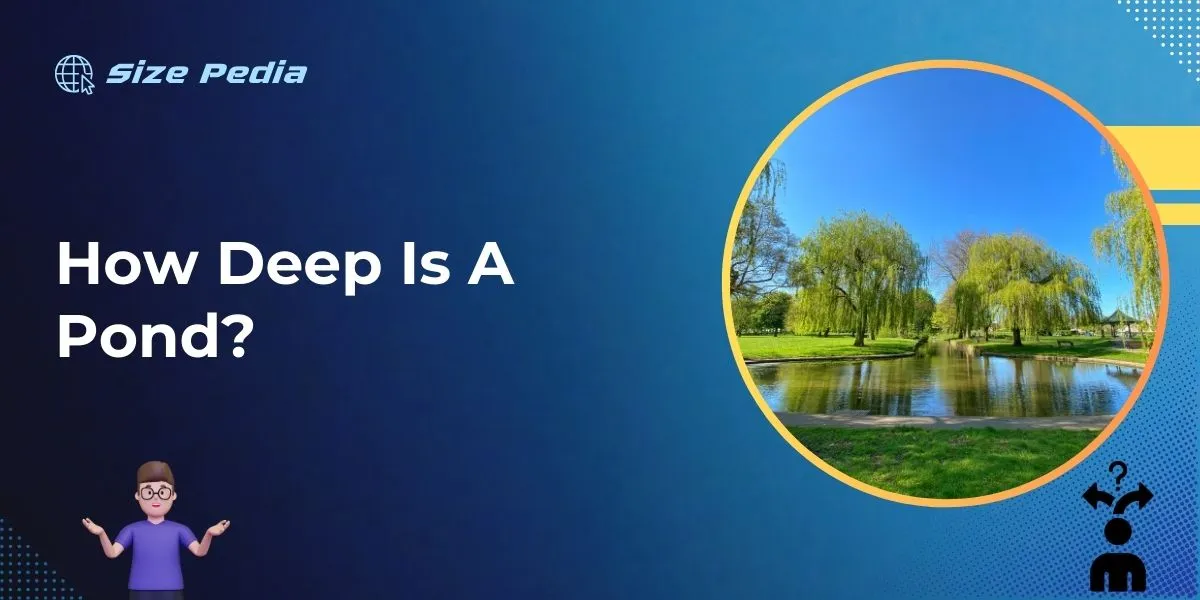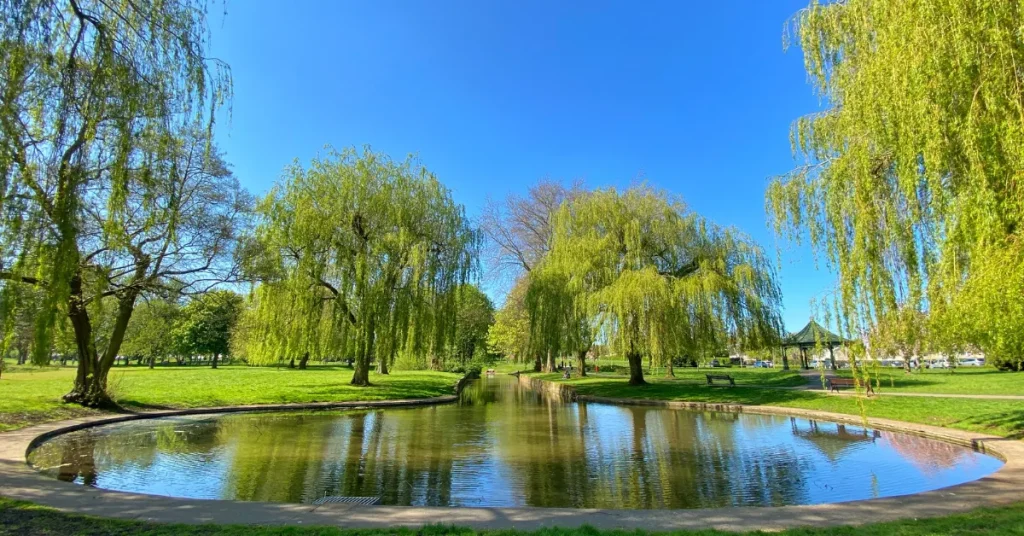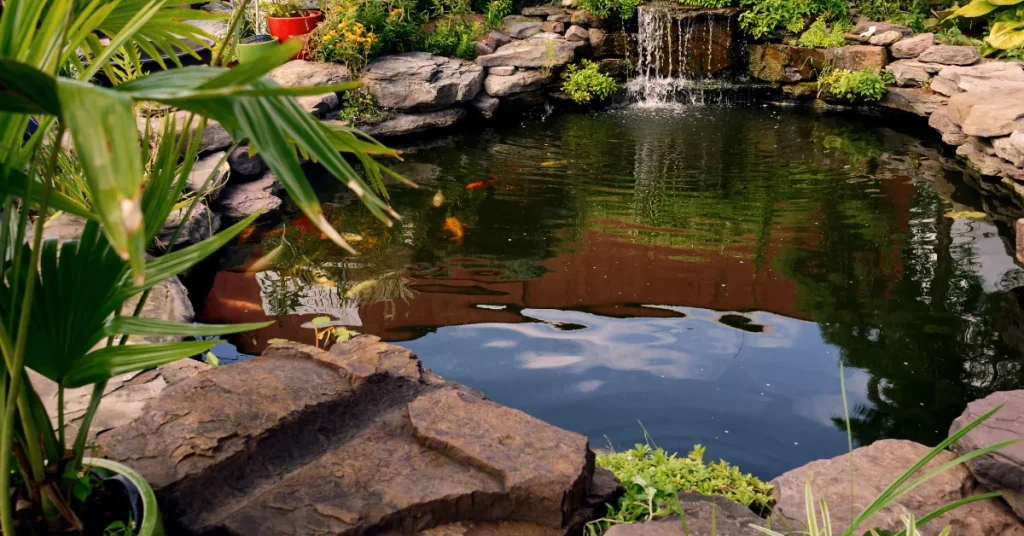Pond depths can vary widely, typically ranging from 1 to 3 meters. Deeper ponds exist, especially if they’re man-made for specific purposes.
Understanding the depth of a pond is crucial for both ecological balance and maintenance purposes.
Shallow ponds are susceptible to temperature fluctuations and can foster algae growth, while deeper ponds regulate temperature better and provide a more stable environment for aquatic life.
For homeowners considering a garden pond, depth is an important factor in determining the types of plants and fish that can thrive.
Natural ponds may have varying depths due to the landscape, whereas artificial ponds offer more control over this aspect. The depth of a pond also affects its overall health, influencing factors like oxygen levels and water quality.
Whether you’re a hobbyist or an environmental scientist, getting to know the characteristics of pond depth is key for effective pond management and sustaining a vibrant ecosystem.

The Depths Of Freshwater Ponds
The mesmerizing world beneath the water surface of freshwater ponds has long fascinated nature lovers and scientists alike.
Understanding how deep these bodies of water can be is not only interesting, but also crucial for the ecosystem within and around them.
Let’s dive into the factors that determine the depth of these serene environments and explore the common ranges seen across various regions.
Factors Influencing Pond Depth
A pond’s depth can vary widely and is shaped by several key factors:
- Local climate: Warmer areas may have shallower ponds due to higher evaporation rates.
- Geology: The type of soil and rock can affect how much water a pond can hold.
- Size and shape: Larger ponds may have deeper centers while smaller ones are typically shallower.
- Human intervention: Many ponds are dug out or dammed by people, influencing depth.
- Natural events: Weather patterns like droughts or floods can alter depths over time.
Common Depths Across Various Regions
In different parts of the world, freshwater pond depths can vary. Let’s look at what is typically seen:
| Region | Common Depth Range (feet) |
| Northern America | 6 to 12 |
| Europe | 4 to 10 |
| Asia | 5 to 15 |
| Africa | 3 to 12 |
| Australia | 5 to 20 |
Note: These depths are averages and can differ based on specific factors discussed earlier.
Aquatic Life And Depth Correlation
The depth of a pond plays a key role in determining the types of aquatic life it can support. Deeper waters create different environmental conditions.
These conditions result in diverse ecosystems. Let’s explore how depth impacts the biodiversity and adaptability of aquatic organisms.
Species Diversification With Depth
As a pond deepens, the variety of habitats increases. This leads to greater species diversification. Here’s an overview:
- Shallow zones: Home to amphibians and waterfowl.
- Middle depths: Inhabit insects and medium-sized fish.
- Deep areas: Host larger fish and unique plants.
This stratification fosters various food webs. Food webs support a wide array of species.
Adaptations To Deep Water Environments
Inhabitants of deeper waters face challenges like less light and more pressure. But, their remarkable adaptations ensure survival. Here’s how they manage:
| Adaptation | Function |
| Bioluminescence | Attracts prey and mates in darkness. |
| Reduced metabolism | Conserves energy in low-food environments. |
| Pressure resistance | Survives intense water pressure. |
Creatures like catfish and carp are experts at thriving in deep, murky waters. They showcase physiological changes. Examples include enhanced senses. These senses are useful to navigate and hunt without visibility.
Measuring Techniques For Pond Depth

Understanding the depth of your pond is critical for maintaining a healthy ecosystem. Different ponds have different depths. Measuring techniques help you manage them better. Let’s explore how to measure pond depth accurately.
Traditional And Modern Methods
Traditional methods of measuring pond depth involve simple tools. You might need a weighted line or a stick. People have used these for years.
They work well for smaller ponds. Now, modern methods use technology. Devices like echo sounders or SONAR are examples. These can measure depth quickly. They work for deeper and larger ponds.
- Weighted Line: Tie a weight to a rope and lower it until it hits the bottom.
- Measuring stick: Use a marked stick or rod, great for shallow areas.
- Echo Sounder: This device sends a sound wave and measures the time it takes to return.
- GPS Mapping: Combines depth with location, used for detailed pond maps.
Accuracy And Limitations Of Depth Gauging
Measuring pond depth may seem straightforward, but it has challenges. The accuracy of traditional methods suffers in murky water.
Also, they might be less precise for uneven pond bottoms. On the other hand, modern techniques, while accurate, can be costly. They might need special training to use.
| Method | Accuracy | Limitations |
| Weighted Line | High in clear, calm water | Less accurate in murky or turbulent water |
| Measuring Stick | Good for shallow depths | Not suitable for deep ponds |
| Echo Sounder | Very accurate | Can be expensive; requires power source |
| GPS Mapping | Extremely accurate | Costly; Needs technical knowledge |
In conclusion, understanding the depth of a pond matters for its care. Various tools exist for this purpose. Each has its strengths and weaknesses. Choose wisely based on your pond’s size, clarity, and your budget.
Impact Of Depth On Pond Ecosystems
Understanding how deep a pond is can unravel the mysteries of aquatic life. The depth of a pond plays a crucial role in shaping its environment.
Not only does it influence water conditions, but it also impacts the types of organisms that can thrive within. Let’s dive into how these underwater ecosystems are affected by their depth.
Influence On Temperature And Oxygen Levels
Pond depth significantly affects water temperature and oxygen availability. Here are some key points:
- Shallow ponds warm up and cool down quickly, leading to greater temperature fluctuations.
- Deeper ponds maintain a more stable temperature, providing a consistent habitat for aquatic life.
Oxygen levels also vary with depth. Surface water absorbs oxygen from the air. This oxygen-rich water can mix into shallow areas easily. In deep ponds, however, the bottom layers might become depleted of oxygen without proper circulation.
Depth’s Role In Ecosystem Health And Productivity
The depth of a pond influences its biodiversity, plant growth, and overall health in several ways:
| Depth | Light Penetration | Plant Growth | Animal Habitats |
| Shallow | High | Abundant | Diverse, with more edge-dwelling species |
| Deep | Low | Limited to surface layer | Favorable for fish and deep-water organisms |
Shallow zones are rich with plants and provide habitat for insects and amphibians. Deep waters, on the other hand, offer refuge for fish and can reduce the growth of algae by limiting sunlight.
Human Interaction And Pond Depth Alteration

Human actions can change how deep a pond is. People can dig ponds deeper or fill them in. They can also build near ponds. This affects the water and creatures that live there.
Effects Of Development On Natural Ponds
Building homes and shops near ponds can cause big changes. When the ground is paved, rain can’t soak in. Instead, it runs into the pond. This can make the pond deeper. But sometimes, dirt washes into the pond.
This dirt can fill the pond and make it shallower. Also, people might take water from ponds for buildings. This can make the pond too shallow for fish and plants.
- Construction runoff increases sedimentation.
- Water diversion for urban use decreases pond levels.
- Pollutants from buildings can harm pond ecosystems.
Conservation Efforts To Maintain Depth Balance
People are working to keep ponds healthy. Groups make rules to protect ponds. They watch how deep ponds are. They help fix problems like too much dirt or not enough water. This keeps the water clean and safe for animals.
- Building protective barriers to control erosion.
- Regulating water usage to prevent ponds from drying out.
- Restoring habitats to support pond life.
FAQs About How Deep Is A Pond
What Determines The Depth Of A Pond?
The depth of a pond is typically determined by its use, location, and size. Garden ponds are often shallow, while larger natural ponds vary based on topography and ecological factors. Man-made ponds can be excavated to desired depths.
How Deep Can Garden Ponds Safely Be?
Garden ponds are generally safe around 24 inches deep. This depth supports a healthy ecosystem and helps prevent ponds from freezing solid in winter, while still being safe for families with small children.
Does Pond Depth Affect Water Quality?
Yes, pond depth significantly impacts water quality. Deeper ponds have more stable temperatures, which can reduce algae growth and support diverse aquatic life. However, very deep ponds may have stratification issues affecting oxygen levels.
What Is The Average Depth Of Natural Ponds?
Natural ponds averagely range from 6 to 7 feet in depth. However, their depth can fluctuate greatly due to factors like regional climate, water source, and geological characteristics.
Conclusion
Diving into the depths of pond knowledge, we surface with a clear understanding. Every pond is unique, from shallow garden water features to deeper natural basins.
Remember, the depth impacts ecology, maintenance, and usage. Ready to explore your pond’s depths?
Let these insights guide your journey. Stay curious, and dive deeper!
Resources:
1. https://extension.psu.edu/pond-measurements-area-volume-and-residence-time
